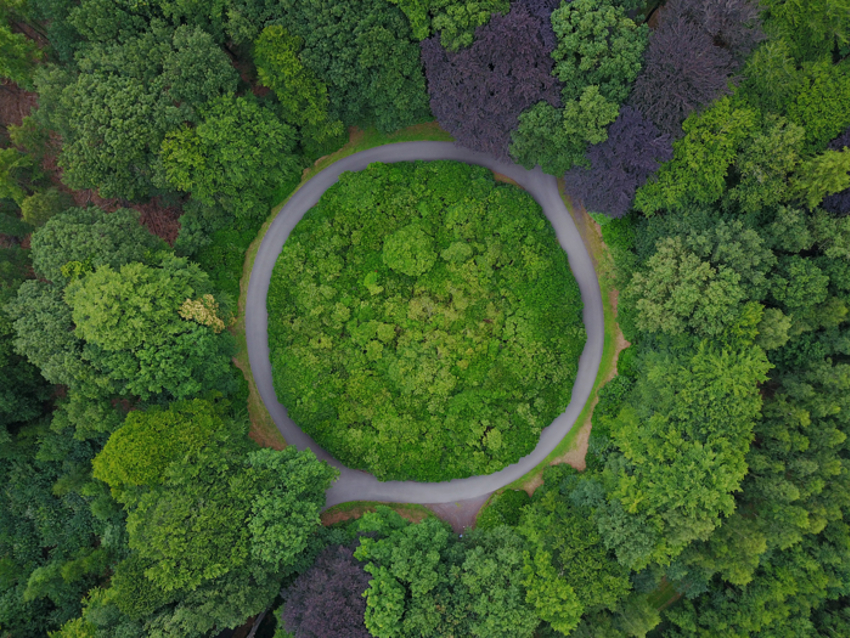Resilience through time
Resilience is the capacity of a building to absorb shocks, recover from disruptions and adapt to changing conditions, ensuring long-term environmental, social and economic stability. Resilience is essential in a world facing climate change and other global challenges.

Etymology of resilience: Recovery and adaptation
The dictionary defines resilience as 'the ability to recover from difficulties or disturbance'. It originates from the Latin term 'resilio', meaning to return to a state or spring back.
In the 19th century, resiliency was defined as the capacity of specific materials to withstand specific disturbances, and it was applied in engineering to enhance the resilience of buildings and materials.
In the 20th century, researchers studied various forms of resiliency and found that a framework could be applied to multiple subjects, including resilience in connection to psychology, risk exposure and resilience in ecological systems, among others.
Resilience is about designing systems and their reactions to shock events, i.e., what a time of anticipation is and the time for recovery and adaptation. The ways the systems respond and possibly adapt depend on their resilience, which can vary from adaptive resilience to resilience based on the recovery time (i.e., returning to the state or taking longer to recover) and ultimately failing, meaning that there is no resilience.
Difference between resilience and resiliency
There is a slight difference in meaning between 'resilience' and 'resiliency'; both are nouns referring to the ability to recover from adversity.
Definitions:
'Resilience' is the general ability to cope with and bounce back from difficult life events, stress, trauma or misfortune.
'Resiliency' also refers to the capacity to recover and adapt after facing adversity, often used to describe the tendency or capability to rebound.
Resilience is the more common and widely accepted form, a variant that may be preferred in specific fields, such as engineering or business. For most situations, resilience is more widely used and generally preferred.
What should you know about resilience?
When we talk about resilience in connection to the buildings today, we talk about the climate-related events (climate change, extreme weather disasters, etc.). All buildings, regardless of location, are subjected to the conditions and forces imposed on them from the natural environment. The concept of resilience is gaining attention in terms of durability to withstand climate-related events, and at the same time, redundancy is also being designed to protect building occupants when critical building systems fail.
Design professionals and building codes address and strengthen buildings' resiliency to a basic level through engineering and architectural approaches, using, for example, material durability and withstanding ability, including absorption effects.
The USGBC and LEED green building certification define resilience as 'the ability to prepare and plan for, absorb, recover from and more successfully adapt to adverse events'.
Resilience in construction and engineering
The four Rs of resilience are:
- Robustness (withstanding events without suffering loss of function)
- Resourcefulness (identifying resources and problems)
- Redundancy (having various paths to enable continued function)
- Rapidity (setting priorities to restore in a timely manner)
In engineering and construction, resiliency refers to the ability to absorb or mitigate damage without suffering complete failure.
The objective of resilience is to design, maintain and restore buildings, infrastructures and communities - in order to ensure their long-term sustainability.
Difference between sustainability and resiliency
Sustainability focuses on meeting the needs of the present without compromising the ability of future generations to meet their needs. Resilience ensures that even during unforeseen events, it does not fail catastrophically and continues operations.
Resilience through repair and reuse (including many other Rs) is a relatively new and rapidly developing building phenomenon. Resilient design and architecture practice find ways to extend the use of buildings. A very high level would be the resilience plan for the unexpected, which could, for example, involve fixing a building after an unforeseen event. Resilience planning allows communities, infrastructures and systems to bounce back after events. This also embodies the idea of a circular economy, allowing buildings, for example, to be disassembled and reused in future projects after unforeseen events.

What happens when unexpected challenges arise?
We are a 24/7/365 repeat society and we prefer to be prepared for everything. But what happens if we cannot be prepared, if we don't know what will happen, or if things change rapidly, dramatically or unexpectedly? These uncertainties are not unrealistic, but not always planned for:
- Climate change and weather-related disruptions such as natural disasters, extreme weather patterns, sea-level rise, worldwide temperature fluctuations, heatwaves and snowstorms, wildfires and flooding, earthquakes and volcanic eruptions.
- Global health-related outbreaks, including pandemics and epidemics (building-related illnesses and long-term issues, indoor environmental and indoor air quality, problems with humidity and moulds, outdoor/indoor air pollutants and allergens).
- Technological and infrastructure failures such as power outages, failure of building systems, interruption in water and food supply, etc.
- Human-caused events such as interruption of information transmission, rapid policy/regulations shifts, natural resources and material disasters, mass migration and behavioural changes, to mention some.
When we try to prepare or respond to the above, we turn to our basic instinct and seek shelter - in buildings that can keep us safe.
IEQ to enhance people's health resilience
We – humans – are indoor creatures, so we can safely say that our new habitat is indoors. Considering that the average lifetime of a male from Europe is 79 years and he spends 6 only years outdoors. Thus about 69 years of a human life is spend indoors – in buildings.While we spend>85% of our time indoors, it means that the indoors must provide good air for our breathing and a good indoor climate.
However, the quality of the indoor environment (IEQ) is still overlooked because it is often assumed that we can easily adapt and tolerate much of it. Building regulations and standards are often written to meet minimum requirement levels. So, we design for a nonexistent average man (~one size fits all) simply because we can 'adapt'.
- We must address the combined effect of indoor environment quality in buildings, not only addressing one parameter of IEQ at a time.
- The way forward is resilience and flexibility in building design & operation.
- We need IEQ rating schemes that include health-performance indicators for people.
- Change is needed - to design and build buildings that promote health (not just avoid risks).
We start by demonstrating the invisible indoor environment to building occupants, making it visible and raising awareness. By creating a positive message promoting health and IEQ, we can also create positive sensations, fulfil people's preferences, allow active adaptation, and enhance people's health resilience and immune response.
Addressing health-related issues through resilience
We need to change the framework by altering our thinking that indoor spaces are not just providing safe shelters for us, but are protecting people every day. Buildings must adapt to protect lives, investments and ecosystems.
A key element is resilience in healthy buildings, where the built indoor environment is no longer an option but a necessity. Health, sustainability and resilience perspective must be included in buildings through resilience.
We have to examine the problem individually and holistically.
- Future-proofing our homes and making them adaptable to environmental changes, such as all-year-round allergy seasons, can help people feel secure and provide control in uncertain times.
- We need to be more aware, and more information is necessary regarding outdoor forecasts, public health communication, and monitoring of airborne allergens.
- To improve long-term liveability, we must focus on resilient principles and design buildings that can withstand weather extremes and environmental stressors like pollen and other airborne allergens.
- We can use green resilience and create landscape design by integrating low-allergen species in city plantings and creating green spaces serving as barriers against pollen and other allergens so that they can protect us outdoors.
- We must examine how people can individually cope with allergens and link this to building resilience and our society.
- Building community resilience by managing allergies as a shared task for all people and all spaces to care for – at schools, in workplaces and in public buildings.
Looking for resiliency in building systems
We can connect sustainability, circularity and resilience in buildings, as all buildings are designed and built to withstand external stressors – extreme weather-related disruptions, global health-related outbreaks, technological and economic failures and rapid human-caused changes. We are constantly looking into preparing ourselves for the unexpected, and we already know that buildings are one of the key elements.
- Reducing building emissions helps mitigate long-term climate problems. Energy-efficient buildings are also better prepared for grid disruptions or energy price spikes.
- Critical building systems, such as well-designed HVAC systems, are needed to ensure people's comfort and health during extreme weather events.
- Monitoring systems that uphold indoor environmental quality with adaptability features are also required to overcome climate challenges.
- Circularity makes supply chains more robust and less dependent on non-renewable materials.
- In the long term, humanity must focus on extending the limited supply of non-renewable resources.

Linking transition in the HVAC industry to sustainability and resilience
A high-quality, resilient and sustainable indoor environment is a key feature in buildings as it directly impacts building occupants' health, comfort and productivity, even during unexpected events. Optimising the indoor climate provided by low-energy and energy-efficient HVAC systems in buildings can reduce operating costs and lower environmental impact while maintaining performance under unpredictable and intense conditions. It can also reduce dependency on external energy resources, even during system failures.
Read our Update&Insight 'Linking transition in the HVAC industry to sustainability and resilience'
The river does not rage against the rocks in its path; it simply flows around them, shaping its own course with patience and persistence. Strength is not always about resistance — it is often about adaptability.Shivanshu K. Srivastav, an Indian writer, newspaper columnist and legal professional